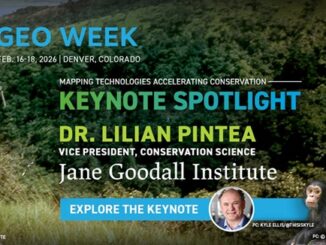For the first editorial for the new Canadian web magazine for geomatics I have been asked to comment on where we have been in the past, where we are today, and what the future may hold for our industry and our community. What a challenge! There have been a number of books written on the subject – including “Men and Meridians” and the more recent update (and more politically correct) “Mapping a Northern Land,” and our own book “Why ‘Where’ Matters.” This will be the short version.
First off, some history. “Geomatics” came into common use in Canada in the 1980s as a term amenable to use in both English and French to embrace all of those subjects that deal with location. Then, as today, geomatics included land survey, remote sensing, geodesy and GPS, mapping and GIS. But Canada’s expertise did not begin in the 1980s. With a huge land mass, the longest coastline in the world, and abundant natural resources, Canada as a nation and we as its people needed to understand our country and its resources. In the end, that is what has driven geomatics – the need to understand our environment.
An aerial photography program began between WW I and WW II. An added impetus came after the last war when a number of returning service men with the requisite experience started aerial survey firms that provided the imagery to the Surveys and Mapping Branch used to create topographic maps – over 13,000 of them. That informal group of aerial surveyors was formalized as the Canadian Association of Aerial Surveyors under the leadership of a larger-than-life war-hero, the late Don McLarty (http://www.rafcommands.com/forum/showthread.php?11449-Donald-McLarty-RIP). The Association then morphed into the Geomatics Industry Association of Canada.
From the post-war years to the 1970s Canadian companies dominated the international aerial survey market, and several GIS software companies were successful in a number of niche markets. While most of the big commercial aerial survey players are now gone (and therein lie some fascinating stories!), there remain a number of active and excellent companies. Along the way GIS was invented in Canada (related to the Canada Land Inventory) and the Canada Centre for Remote Sensing, which was formed some forty years ago, spawned an entire industry. Government was very important for companies like Optech that supplied airborne instruments, and those early suppliers that dominated the world’s image analysis system market like Dipix and PCI. Government also played a key role in the success of MDA’s satellite receiving station business. MDA had over 90% of the market at one time. Today new companies are as likely to have seen their start working with a university lab (like the GPS companies that grew with the University of Calgary’s program, or those in geomatics software spawned by Laval or UNB).
From the position of dominating a number of large markets we have seen Canadian companies move more into niche areas. The reasons are many. Some would say that the fact that the Government of Ontario did not buy their GIS systems from Tydac and/or Geovision eventually led to the demise of those companies and the domination of ESRI. (These same people fail to mention that ESRI Canada is, in fact, a Canadian company with significant international business.) Others point to the attempts of the former Surveys and Mapping Branch to parcel out contracts to many small suppliers rather than letting one or two firms dominate and thus be bigger and better able to take on the world. Others point to unique circumstances surrounding the failure of a couple larger companies – including favouritism shown to local firms by a foreign government and a poorly supervised foreign aid contract. Another factor is that many of those in the industry were what I call “techno-entrepreneurs.” The company owners were more interested in being immersed in the technology than in building a company. While there were a few exceptions, the result is that most companies that were started based on clever Canadian ideas remained small. Having said that, a number of these small Canadian geomatics firms have made their owners comfortable in retirement.
But today we are still very good in a number of areas, and while the post-war veterans have long since retired, as have many of those who entered the field in the early 1970s, the field is renewing itself – as this new publication would indicate. Our strengths in Canada include education, research, geospatial data infrastructures, GPS, many aspects of remote sensing and its application (including Lidar and radar), the use of GIS, and also the application of these technologies in international development – a huge if highly fragmented and increasingly competitive market. Another interesting aspect of the field today is that more geomatics professionals are working for companies and agencies whose primary business is not geomatics. They work for environmental consulting firms, forestry companies, engineering firms, retailers, banks, etc. This leads to more fragmentation among those of us in the field. Simply stated, it is hard for us all to get together.
While there have been some recent successes, there are some storm clouds. The strong dollar has made us less competitive as exporters. At the same time the strong dollar leads to increased competition at the technical level from lower-wage countries like India and China – both of whom have long recognized the importance of geomatics to their continued development. The state of the US economy (not to mention that of the rest of the world) has also had an impact on the export side of the business. At the same time as these issues are looming over us, those organizations that represent industry, and those of us who work in the field, are becoming ever more fragmented. The many organizations also seem even more careful about guarding what turf remains in their control while (and perhaps because) their financial strength is eroding.
Along with these organizational issues we have, as noted above, a highly fragmented workforce in the field: we no longer all work for geomatics companies and organizations. This fragmented workforce is difficult for the more traditional organizations to identify, much less serve. Furthermore, as people retire renewals tend to be down, and those members left tend to be older and perhaps not as in-tune with the needs of a younger, more mobile workforce. This leads to what may become a vicious downward spiral. Why are members leaving the traditional scientific and technical organizations? Why are younger members not joining them? The usual reason is the lack of relevant services for members. But what is the answer? Simply stated, organizations that purport to serve our community must be relevant and provide value – to all members and, especially, to those who may become members.
So, is there any good news? Yes! GEOIDE has been a success. As a result we have a well-established academic and research community. The Federal Government has committed to refurbish all of the CCRS ground stations and add capacity in Inuvik – at a time when budgets generally are being reduced. TECTERRA has come on the scene with the mandate to build industry – and seems to be doing just that. The Federal Government has not only supported TECTERRA (along with the Government of Alberta), it has funded a group headed by C-CORE to develop EO applications in the north. Finally, the Federal Government has brought together geomatics and earth observation into one committee where there used to be two. And where the “Feds” go, many organizations often follow.
Could it be that the various organizations in the geomatics and EO fields that today represent industry, academe, and those in the professional and technical sides will find shelter under a common structure? By so doing they would reduce costs and be able to provide new services such as a one-stop shop for information, access to professional development, links to industry (and jobs), and a common voice to serve as an advocate for the field as a whole – including the younger members of our profession just starting in this exciting field. Maybe this magazine and the services it offers will be the first step. I hope so.
Bob Ryerson, Ph.D., CMS, FASPRS
Manotick, Ontario
Dr. Ryerson has held positions in remote sensing in government ranging from Senior Environmental Scientist to Director General. In the private sector he has been Vice-President and President of several companies. He has been elected to serve on the boards of scientific organizations in Canada and the USA, as well as on the boards of a number of companies and a national industry association. He has also been an adjunct professor in Canada, the USA, India and Australia. He has received numerous national and international awards, including the 2012 Gold Medal from the Canadian Remote Sensing Society. Ryerson and his colleague Dr. Stan Aronoff have recently published a highly acclaimed book “Why ‘Where’ Matters.” The book, which has now sold into 29 countries, is available at www.geoeconomy.com





Be the first to comment